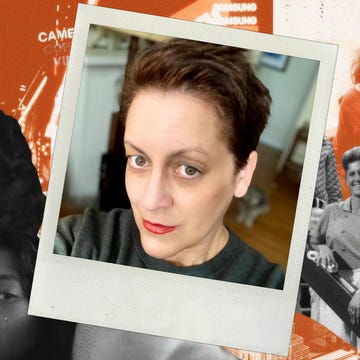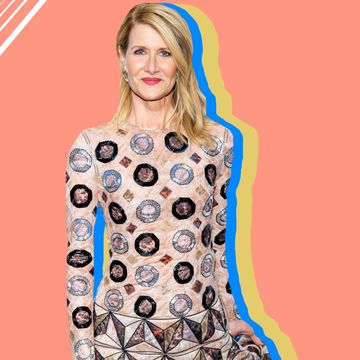On February 28, the 15th episode of Grey's Anatomy's 15th season will officially make it the longest running primetime medical drama in television history. As we build up to this monumental TV moment, we've asked five writers, all of them Grey's groupies since the first season, in 2005, to tell Shondaland.com why the seminal drama series has meant so much to them over 330 (and counting!) episodes.
Grey's Anatomy first aired in 2005, the year I began high school. In short order, I became engrossed in the series' now-iconic characters, their dynamics, and the bevy of medical cases that the interns, residents, and the rest of the hospital staff found themselves dealing with week after week. In fact, I became so absorbed by the medical drama that one of my best friends — the Meredith to my George, if you will — gave me an actual copy of the Gray's Anatomy textbook for my birthday. It was the perfect gift, one that encapsulated my love of my favorite show and my chosen career goal: doctor.
I saw that goal through when I entered the University of North Carolina at Chapel Hill, where I declared myself a pre-med major. Only it didn't take long for me to realize that this wasn't exactly the future I wanted, that I'd actually much rather, ya know, write about Grey's Anatomy than don the scrubs myself. That said, the cases depicted on the show were nonetheless captivating, and, to this day, I still get excited tuning in each week to see what crazy, cool, can't-turn-away medical mystery the staff of Grey Sloan Memorial Hospital will have fall in their laps.
Let's start with the crazy. In 15 seasons, Grey's has presented some cases that, as bonkers as they might seem, are apparently all based in factual studies or cases from real hospitals. And boy, have there been some doozies: the woman with a 70-pound tumor, the pregnant man, the patient who was part tree, and the one who was essentially turning into a lion. Who could forget the man who swallowed plastic doll heads, the girl who couldn't feel pain, the boy who was encased in cement, the woman who had seven to eight spontaneous orgasms a day, and the man who, while peeing, had a small fish swim up his urine stream into his penis? And that's just a handful — remember, there have been over 330 episodes.
As entertaining as it all is for viewers, though, these off-the-wall cases are typically meant to leave a lasting impact on our favorite docs, all in the name of bringing them to some greater realization about themselves or the people in their lives.
Consider when we met Bonnie and Tom, two strangers who become impaled on the same pole after being involved in a massive train wreck. Watching the team toil over how to separate the two reaches a heart-wrenching climax when they realize there's only one solution: just one of them can make it out alive. Bonnie, a younger woman with more serious injuries, selflessly offers to let Tom, the older man whose injuries are less severe, live, and in the process we see Derek facing his own difficult decision: choosing between Meredith and Addison. He has feelings for both and, no matter what choice he makes, someone is going to get hurt.
Then there was Cristina's goal of printing a 3D heart. The self-proclaimed "Cardio God" set out to do what was considered the impossible — and something we're still figuring out in the real medical world today. It was the perfect goal for Grey's most driven surgeon, and it truly pushed Cristina's story forward — so much so, in fact, that she moved to Switzerland soon after to further her career. Even in Grey's current season, the medical drama continues to facilitate character breakthroughs: Just last week, Meredith completed GSMH's longest surgery ever, a pancreas-sparing total duodenectomy in a frozen abdomen (what a mouthful!) that clocked in at 29 hours and 8 minutes.
Also, how can we forget Jackson and April's first child, Samuel, who died because of an aggressive type of osteogenesis imperfecta, which resulted in the baby's bones breaking shortly after birth? Already on the rocks as a couple, the stress of their gravely ill child exposed the unmendable fractures in their relationship, ruptures that, despite Jackson and April eventually experiencing parenthood with their second child, contributed to their eventual separation.
But Grey's isn't all mass traumas and surgical head-scratchers. Sometimes it's the most normal — or relatable — cases that aim to shed light on the very real health issues in the United States. From the very beginning, we watched Meredith come to terms with her mother, former award-winning surgeon Ellis Grey, and her battle with Alzheimer's, which currently affects an estimated 5.7 million Americans, the majority of them women. Denny — sweet, sweet Denny — had his blooming relationship with Izzie cut short when he succumbed to heart disease, the leading cause of death for both men and women in the US. Speaking of Izzie, she defeated cancer, joining the ranks of an estimated 15.5 million Americans who are survivors. Then there's the way we lost both George and Derek: death by motor vehicle. Though George was hit while saving a fellow pedestrian's life and Derek was hit while helping at the scene of a crash, motor vehicle fatalities took the lives of 1.35 million people across the world in 2018. During last week's episode, victims of a mass opioid overdose descended upon Grey Sloan Memorial, just as our country currently struggles to deal with a very real opioid addiction crisis, which accounted for 70,000 deaths in 2017.
Wherever on the spectrum of fantastical that the cases on Grey's Anatomy fall, they — like those in all the medical dramas that came before it and those that will (and have) come after it — exist for a purpose beyond just nail-biting viewing. These polar extremes, in the grand scheme of things, heighten the ups and downs of what comes in-between: characters coming together and growing apart; doctors and nurses reaching life milestones and facing professional failures; people facing losses both big and small, and then figuring out how they move forward in life. These realities, in effect, look like our own, and as these doctors face the gamut of the human experience, they allow us to do the same.
I'll admit that this is all coming from someone who left the prospects of medicine behind to pursue a passion for the written word. I can promise you this, though: I may have given up on joining the ranks of Grey's Anatomy's fictional professionals, but I will never give up on Grey's Anatomy.
Get Shondaland directly in your inbox: SUBSCRIBE TODAY












